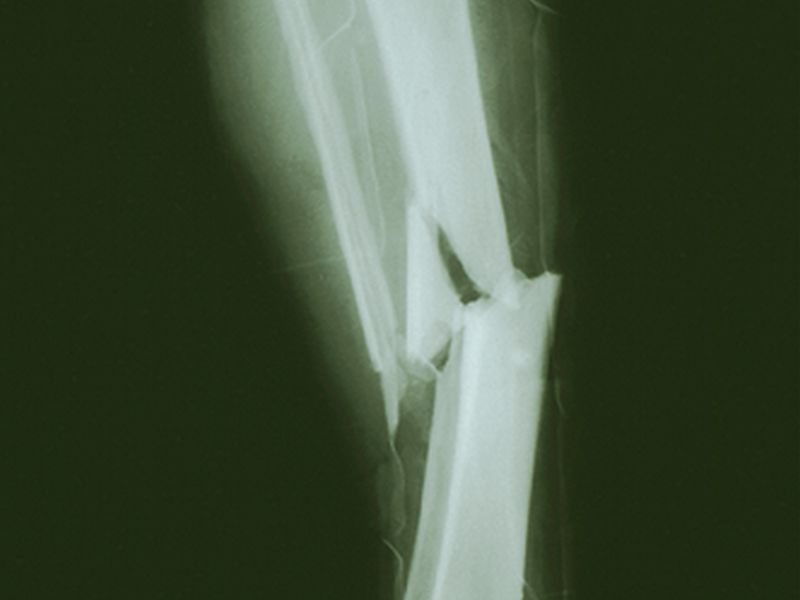

Gene Therapy Might Someday Mend Badly Broken Bones
Animal experiments suggest this may be a potential alternative to bone grafts, researchers sayWednesday, May 17, 2017

WEDNESDAY, May 17, 2017 (HealthDay News) -- An experimental method that combines gene therapy, stem cells and ultrasound has healed large bone breaks in lab animals, researchers have found.
The technique is far from becoming a reality. But, it repaired large bone gaps in the mini-pigs scientists studied. The hope, the researchers say, is to eventually help people with badly broken bones that won't heal.
When a bone sustains a simple fracture, it is usually able to self-repair with time (and a cast). However, severe fractures can leave large gaps in the bone that the self-healing process cannot bridge.
Right now, the "gold standard" treatment for those fractures is bone grafting, said Dan Gazit, one of the senior researchers on the new study.
There, surgeons take bone tissue from elsewhere in the body -- or from a donor -- and use it to repair the damaged bone.
There is a need, however, for alternatives, said Gazit, a professor of surgery at Cedars-Sinai Medical Center, in Los Angeles.
When bone grafting is done with a patient's own tissue -- often taken from the pelvis -- that means additional surgery. And it can leave patients with prolonged pain and added risk of infection, Gazit said.
Meanwhile, donor bone from a tissue bank has its own issues, he noted.
It is "dead bone," Gazit explained, adding it often fails to integrate into a patient's own bone to repair the damage.
So Gazit and his colleagues developed an approach aimed at harnessing the body's natural repair capacity.
First, the researchers implanted a matrix of collagen -- a protein in bone -- into the gap between the two sides of a fractured bone.
That collagen then attracted the bone's resident stem cells, and gave them a structure to settle into. Stem cells are early cells that develop into mature tissue, including bone.
Once those cells have populated the gap in the bone, the next step involves gene therapy. The researchers injected a mixture of "microbubbles" and genetic material for a bone-promoting protein, called BMP, into the injury site.
To get the genetic material into the stem cells, the scientists used an ultrasound wand. It provided the "energy" necessary to get the stem cell membranes to -- very briefly -- open up and allow the DNA fragments in, the study authors explained.
That spurred the stem cells to form new bone tissue, according to the report.
In this study, the tactic healed bone breaks in all of the lab animals the researchers treated, Gazit said. In untreated pigs, the breaks did not heal, the findings showed.
Use of BMP to treat damaged bone is not new. Doctors sometimes use infusions of the protein for certain non-healing fractures.
"But there are problems with BMP," said Dr. Joseph Lane, an orthopedic trauma surgeon at the Hospital for Special Surgery in New York City.
A central issue, he said, is that very high BMP doses may be needed, and side effects -- including infections and excess bone growth -- are common.
"We need to become more sophisticated in how it's delivered," Lane said.
The new approach is "going in that direction," said Lane, who was not involved in the research. The "beauty" of it, he said, is that it harnesses the bone-promoting effects of BMP in a more-natural way.
"But," Lane cautioned, "this is a very early step."
A number of questions should be answered before human trials are done, according to Lane. For example, he said, future animal research should look at more complicated fractures. The bone injuries used in this study are relatively easy to heal, versus severe fractures, Lane said.
What about the safety of injecting genetic material into stem cells?
The BMP gene is active for only a short time before becoming undetectable, the study authors said. That short burst of activity appears to be enough to trigger the bone regeneration process.
Gazit added, "We have strong indications that we're on the right track."
The study was funded by government and private grants. Gazit and two colleagues are inventors on a patent application related to the research findings.
The results were published May 17 in Science Translational Medicine.
SOURCES: Dan Gazit, Ph.D., D.M.D., professor, surgery, and co-director, Skeletal Regeneration and Stem Cell Therapy Program, Cedars-Sinai Medical Center, Los Angeles; Joseph Lane, M.D., orthopedic trauma surgeon, and chief, metabolic bone disease service, Hospital for Special Surgery, New York City; May 17, 2017, Science Translational Medicine, online
HealthDay
Copyright (c) 2017 HealthDay. All rights reserved.
News stories are written and provided by HealthDay and do not reflect federal policy, the views of MedlinePlus, the National Library of Medicine, the National Institutes of Health, or the U.S. Department of Health and Human Services.
- More Health News on
- Genes and Gene Therapy
- Stem Cells




























.png)











No hay comentarios:
Publicar un comentario